#ux optimization
Explore tagged Tumblr posts
Text
When your website needs a UI/UX upgrade
Is your website due for a UI/UX update? If you’re not sure how to answer this question, it probably is. Read this blog to find out how to spot the signs and what to do next.

0 notes
Text
things i really enjoy doing
designing workspaces
asking questions about problems
optimizing processes
these are highly paid jobs in theory, but i think they probably come with a lot of bullshit, so i guess i'll keep being a glorified PC repair technician
#bathroom wall#jobs#process optimization#risk management#ux design#<- hey i've used all of these before! i love them <3
4 notes
·
View notes
Text
Why User-Centered Design is the Key to Online Success: Leveraging Psychology and Design Principles to Create Meaningful Experiences
User-Centered Design (UCD) is crucial in today’s digital world, where success relies not just on aesthetics or functionality but on crafting a user experience that resonates with users on a deeper psychological level. UCD prioritizes not only visual appeal but also the way users think, feel, and behave. Creating effective User-Centered Design is simpler than it may seem; it involves applying psychological principles, such as understanding cognitive load and paying careful attention to even the smallest design details. By focusing on these aspects, we can develop experiences that are not only intuitive but also rewarding. In this blog, we will explore why this approach is essential and how real-world examples highlight its significant impact.

Understanding Human Behavior: The Psychological Pillars of User Centered Design
Every user interaction with a product involves mental processing. If this process is considered overly cumbersome—in other terms if the user experiences a high cognitive load then—there is a likelihood that users will feel an overload and thus get annoyed and quit your site/product. One of the key ideas in user-centric design is reducing cognitive load, or the amount of mental effort required to use and understand a product.
Hick’s Law: Simplifying Choices
Hick’s Law states that the time taken to make a decision increases with the number of alternative choices available to the individual user and hence the more choices available to be used by or have the decision the more prolonged it will take for the user to make a decision. Thus, if a website bombards users with too many actionable options then the users may hesitate or leave entirely. Because of this same reason platforms like Netflix offer recommendations to its users to limit the choices and to show the user what’s most relevant. So, Instead of overwhelming users with the entire library, Netflix focuses on curating options that best fits the user preferences, thus making decision-making easier and faster.

Netflix Interface Showcasing Uses Hick’s Law to Simplify Choices
Fitts’s Law: Designing for Ease of Access
Fitts’s Law explains that why large, well-placed buttons are more effective than small buttons that are hard to reach. Users must have no friction or struggle to find key actions on your website/product. Amazon implements this really well by placing the "Add to Cart" buttons in prominent locations.

Design comparison showing familiar interface versus unfamiliar
These buttons are easy to spot and are large enough to click effortlessly, and also the buttons are placed so strategically to minimize user effort. This simple but thoughtful design element can significantly increase conversions because by doing so Amazon reduces the friction in the user's buying journey.
The Impact of Small Design Decisions: Tiny Tweaks that Leads to Big Results
Small design decisions can lead to a significant difference in how users interact with a product, even if the differences seem atomic or minute at first glance.
The Importance of Spacing
Strategic spacing between elements can drastically improve focus and comprehension. According to the Gestalt Principles of Perception, specifically the Proximity Principle, items placed closely together are perceived as related, while those spaced apart draw more attention individually. Even something as simple as reducing visual clutter makes an enormous difference.
For example, Airbnb uses this principle beautifully. Their listings have plenty of white space, making it easier for users to digest information like pricing, property details, and reviews without feeling overwhelmed. By strategically spacing elements, they guide user attention to what’s most important—booking a stay.
FAQ
Que 1. What is User-Centered Design (UCD)?
Ans 1. User-Centered Design (UCD) is a design method that prioritizes the end user's demands, behaviors, and preferences. It entails studying and understanding customer expectations in order to develop products that are intuitive, simple to use, and aligned with user objectives.
Que 2. How does psychology influence user-centered design?
Ans 2. Psychology has an effect on UCD because it helps creators understand how people think, act, and make decisions. Making digital systems easier to use and more interesting is based on psychological principles such as Hicks' Law (choice time), Fitts' Law (interaction efficiency), and the Gestalt principles (perception and organization).
Que 3. What is the difference between user-centered and conventional design?
Ans 3. The user's demands are prioritized in user-centered design, as opposed to traditional design that prioritizes aesthetics or corporate goals. Whereas traditional design may overlook important user feedback, resulting in usability problems, UCD constantly tests and refines based on user input.
Discover the Full Story
#User-Centered Design#UX design principles#psychology in design#cognitive load#Hick's Law#Fitts's Law#UCD#web design#UI/UX#online success#user behavior#scarcity effect#user experience#digital success#e-commerce UX#Miller's Law#UX design#conversion optimization#UX laws#web design psychology#psychology in Ux#netflix#amazon#Millar's Law#Jakob's law#Instagram#shopify#client centric design#spotify#werbooz
2 notes
·
View notes
Text
"Boost Your Online Store Sales with a Shopify UX/UI Audit!"

Are you looking to improve customer experience and increase conversions on your Shopify store? With Alexis Coutray, a UX/UI designer and conversion rate optimization (CRO) expert, you can get a comprehensive review of your store. Discover how enhancing navigation, design, and user experience can drive more sales. Don’t miss out on the opportunity—book your consultation now and start turning visitors into loyal customers!Get your Shopify UX/UI audit here."
#Shopify UX/UI audit#Boost Shopify conversions#Shopify store optimization#Shopify CRO expert#Increase Shopify sales#Shopify user experience review
2 notes
·
View notes
Text
Enhancing User Experience in Saudi Mobile Apps with AI

In the current digital environment, the triumph of mobile applications is deeply rooted in their user experience (UX). With the rise of artificial intelligence (AI), mobile apps are becoming more intelligent, responsive, and personalized. In Saudi Arabia, where the digital economy is rapidly expanding, integrating AI into mobile app development is not just a trend—it's a necessity. This article delves into how AI is enhancing user experience in Saudi mobile apps, exploring the benefits, challenges, and future prospects.
1. The Role of AI in Mobile App Development
Artificial intelligence (AI) has transformed numerous sectors, and mobile app development is certainly among them. In the context of user experience, AI plays a pivotal role in making apps more intuitive, efficient, and tailored to individual user needs. Whether it's through predictive analytics, natural language processing, or machine learning algorithms, AI enhances every aspect of the user journey.
1.1 Predictive Analytics for Personalized Experiences
One of the key advancements AI has brought to mobile app development is predictive analytics. By analyzing user data, AI can predict future behavior and preferences. This allows apps to offer personalized recommendations, content, and services, thereby improving user engagement and satisfaction.
1.2 Natural Language Processing for Better Interaction
Natural Language Processing (NLP) enables apps to understand and respond to user queries in a more human-like manner. In Saudi Arabia, where Arabic is the primary language, NLP can be particularly beneficial in providing seamless communication between the app and the user. By understanding the nuances of the Arabic language, AI can enhance the overall interaction quality.
1.3 Machine Learning for Continuous Improvement
Machine learning algorithms enable apps to learn from user interactions and continuously improve over time. This means that the more a user interacts with an app, the better the app becomes at meeting their needs. For businesses in Saudi Arabia, this translates to higher customer retention rates and increased loyalty.
2. The Importance of UX in Saudi Arabia's Digital Economy
Saudi Arabia is undergoing a digital transformation, with a significant focus on enhancing the digital economy. Mobile apps are at the forefront of this transformation, serving as key platforms for e-commerce, banking, entertainment, and more. In such a competitive market, delivering a superior user experience is crucial for success.
2.1 User-Centric Design: The Key to Success
A user-centric design approach is essential for creating apps that resonate with the target audience. In Saudi Arabia, this means considering cultural nuances, language preferences, and the unique needs of the local population. By integrating AI into the design process, developers can create apps that are not only functional but also emotionally engaging.
2.2 The Impact of AI on User-Centric Design
AI can analyze vast amounts of data to identify user pain points and preferences. This information can then be used to design more intuitive interfaces, streamline navigation, and offer features that align with user expectations. For example, AI can propose design modifications based on user feedback, ensuring the app stays relevant and user-friendly.
3. AI-Driven Personalization: A Game Changer for User Engagement
Modern user experiences are deeply rooted in personalization. With AI, mobile apps can deliver highly personalized experiences that keep users engaged and satisfied. From personalized content recommendations to tailored notifications, AI-driven personalization is a game changer for user engagement.
3.1 Personalized Content Recommendations
AI-driven algorithms can assess user behavior to suggest content tailored to their preferences. This is particularly valuable in entertainment apps, where users are more likely to engage with content that resonates with them. In Saudi Arabia, where digital content consumption is on the rise, personalized recommendations can significantly enhance user experience.
3.2 Tailored Notifications for Better Engagement
Notifications are a powerful tool for keeping users engaged with an app. However, generic notifications may often be seen as intrusive. AI can help by sending tailored notifications based on user behavior and preferences. This ensures that users receive relevant updates that add value to their experience.
4. Enhancing Mobile App Security with AI
Security is a top concern for mobile app users, especially when it comes to sensitive information such as financial data. AI can enhance mobile app security by detecting and preventing threats in real-time, providing users with a safer experience.
4.1 AI-Powered Fraud Detection
AI can analyze patterns in user behavior to detect fraudulent activities. For example, if an unusual transaction is detected, the app can alert the user and take preventive measures. This is particularly important for financial apps in Saudi Arabia, where trust and security are paramount.
4.2 Ensuring Data Privacy with AI
Data privacy is a significant concern in the digital age. AI can help ensure that user data is handled securely by monitoring data access and usage. By integrating AI into mobile app development, businesses can build trust with their users by demonstrating a commitment to data privacy.
5. The Future of AI in Saudi Mobile Apps
The outlook for AI in mobile app development in Saudi Arabia is exceptionally promising. As AI technology continues to evolve, we can expect even more innovative solutions that enhance user experience.
5.1 AI and Augmented Reality (AR) Integration
One of the most thrilling advancements is the potential for combining AI with augmented reality (AR). This integration promises to create more immersive and interactive experiences by blending digital information with the physical world in real time. This combination can create immersive experiences that blend the digital and physical worlds. For example, AI-powered AR apps can offer personalized shopping experiences, allowing users to virtually try on products before making a purchase.
5.2 Voice-Activated Apps Powered by AI
Voice-activated apps are becoming increasingly popular, thanks to advancements in AI and NLP. In Saudi Arabia, where voice assistants like Siri and Google Assistant are widely used, integrating voice activation into mobile apps can enhance accessibility and user convenience.
Conclusion
AI is transforming the landscape of mobile app development in Saudi Arabia, offering new opportunities to enhance user experience. From personalized content recommendations to advanced security features, AI-driven apps are better equipped to meet the evolving needs of users. As the digital economy in Saudi Arabia continues to grow, businesses that leverage AI in their mobile apps will be well-positioned to succeed in this competitive market.
FAQs
1. How does AI improve user experience in mobile apps?
AI enhances user experience by personalizing content, improving app security, and enabling more intuitive interactions.
2. Why is user-centric design important in Saudi mobile apps?
User-centric design ensures that the app meets the unique needs and preferences of the local population, leading to higher user satisfaction.
3. How can AI enhance mobile app security?
AI can detect and prevent security threats in real-time, ensuring that user data is protected.
4. What is the future of AI in mobile apps?
The future of AI in mobile apps includes the integration of augmented reality and voice activation, offering even more immersive and accessible experiences.
5. Why is personalization important in mobile apps?
Personalization keeps users engaged by delivering content and notifications that align with their interests and preferences.
#AI in Saudi mobile apps#User experience optimization#Saudi Arabia mobile UX#AI-powered app features#Mobile app development Saudi Arabia#AI for app user engagement#Saudi mobile apps AI integration#AI-driven UX improvements#Enhancing mobile app usability#AI technology in Saudi apps#AI for better app performance#Mobile user experience AI#AI-based app customization#Advanced AI in mobile apps#AI innovation in Saudi apps
2 notes
·
View notes
Text
Professional Website Design & Development Services

Your website is the cornerstone of your online presence. At MotionDevs, we specialize in crafting digital experiences that convert with our ecommerce website development services. From start to finish, we ensure your online store is built for success. If you’re on Shopify, our dedicated Shopify website development services deliver a customized, high-performing platform tailored to your needs.
Beyond eCommerce, our website design & development services cover everything from sleek designs to robust functionalities, making your website a true reflection of your brand. Our UI/UX design services are crafted to enhance user interaction, ensuring that visitors have a smooth and enjoyable experience. To ensure your site gets the attention it deserves, our search engine optimization services are designed to drive organic traffic and improve your search engine rankings. Partner with MotionDevs and watch your digital presence soar!
#ecommerce website development services#shopify website development services#website design & development services#ui ux design services#search engine optimization services
2 notes
·
View notes
Text
SEO with UX: Building Engaging and Adaptable Websites
Understanding the Relationship between UX and SEO
In the domain of website development, User Experience (UX) and Search Engine Optimization (SEO) are closely intertwined disciplines. Both aim to provide users with a seamless browsing experience and relevant content. UX is dedicated to meeting user needs and expectations, ensuring effortless navigation and engagement. Conversely, SEO focuses on enhancing website visibility and accessibility to search engines, aiming for top rankings in search results and attracting organic traffic. This symbiotic relationship is fundamental in website development and is often overseen by a reputable Digital Marketing Agency.
UX Elements Impacting SEO

Crucial UX elements significantly influence SEO outcomes. Mobile responsiveness, prioritized by Google for mobile-friendly sites, ensures seamless browsing across devices, improving user satisfaction and SEO rankings. Additionally, website speed directly affects user engagement and SEO metrics, such as bounce rates and dwell time. Intuitive navigation and structured content further enhance user experience, reducing bounce rates and signaling relevance to search engines. High-quality content, optimized for relevance and keywords, attracts backlinks and social shares, enhancing search visibility. Engaging visual design elements also contribute positively to user engagement and SEO metrics.
Mobile Responsiveness & SEO
Mobile responsiveness is critical for contemporary websites, given Google’s preference for mobile-friendly sites in search rankings. A mobile-friendly design guarantees optimal viewing experiences across various screen sizes, fostering user satisfaction and engagement—critical factors for SEO success. Prioritizing mobile responsiveness consequently enhances SEO performance, resulting in increased visibility and organic traffic.
Website Speed’s Impact on User Satisfaction and SEO
Website speed significantly affects both user experience and SEO effectiveness. Users expect fast-loading sites, and search engines reward them with higher rankings. Slow websites frustrate users, increasing bounce rates and decreasing engagement, negatively affecting SEO metrics. By optimizing website speed through techniques like image compression and file magnification, website owners improve user experience and SEO performance, leading to increased visibility and organic traffic.
Navigation & Site Structure for SEO Success
Efficient website navigation and structure are essential for enhancing user experience and Search Engine Optimization(SEO) performance. Clear navigation aids users in finding information easily, reducing bounce rates and improving engagement. From an SEO standpoint, a well-organized site facilitates search engine crawlers in indexing content effectively, enhancing visibility in search results. Prioritizing intuitive navigation and structured content thus benefits both user experience and SEO, resulting in a seamless browsing experience and improved search engine rankings.
Balancing Content Quality for UX and SEO
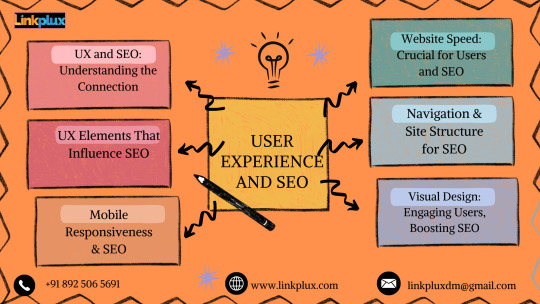
Achieving a balance between content quality for user experience (UX) and Search Engine Optimization (SEO) is crucial for website success. High-quality content engages users and satisfies search algorithms, improving rankings and visibility. Relevant and valuable content meets user needs and encourages interaction, enhancing UX. Meanwhile, well-optimized content signals authority to search engines, improving rankings. Striking this balance ensures informative, engaging, and optimized content, leading to a positive user experience and robust SEO performance, driving organic traffic and overall success.
Enhancing SEO through Visual Design
Visual design plays a significant role in user engagement and SEO. Appealing layouts and multimedia content foster user engagement, signaling relevance to search engines. Additionally, well-designed visuals aid in conveying information effectively, improving content comprehension. Prioritizing visually appealing elements enhances user experience while boosting search engine visibility and rankings.
Insights from User Interaction Metrics for SEO
User interaction metrics provide valuable insights for SEO optimization. Metrics like bounce rate, dwell time, and pages per session reflect user engagement levels. Low bounce rates and high dwell times indicate valuable content, benefiting SEO. Similarly, more pages per session indicate deeper user engagement. Analyzing these metrics helps optimize content and user experience, leading to enhanced SEO performance and increased visibility in search results.
In conclusion, integrating user experience (UX) with search engine optimization (SEO) is essential for website success. Prioritizing elements like intuitive navigation, fast loading times, quality content, and engaging design not only improves user satisfaction but also boosts SEO performance. This synergistic approach leads to improved visibility, higher rankings, and increased organic traffic, ensuring long-term online success.
3 notes
·
View notes
Text
What Role Does User Experience (UX) Play in SEO Rankings?
In the ever-evolving landscape of digital marketing, search engine optimization (SEO) continues to be a crucial aspect of online visibility and success. However, as search engines refine their algorithms to prioritize user satisfaction and relevance, the role of user experience (UX) in SEO rankings has become increasingly significant. Understanding how UX impacts SEO can empower businesses to…

View On WordPress
4 notes
·
View notes
Text
Introducing Shoppy.ing
Announcing Shoppy.ing … our product showcase created using Visual Stories! Check out the visually captivating experience of shoppable Web Stories.
To get this stunning shopping experience on your own website for free, contact us.
#webstories#web stories#visual stories#seo#search engine optimization#web design#ui/ux design#shopify#online shopping#online shop
6 notes
·
View notes
Text
8 UX Tips for Voice Search SEO
💡 Advanced SEO Pro Certification Course by Anil Varma - Registration Link in the first comment. ❤️ Follow Semly Pro - The SEO Company for more SEO tips. 🎙 Content and Design by Surya Pillai Implement these 8 UX Tips for Voice Search SEO:

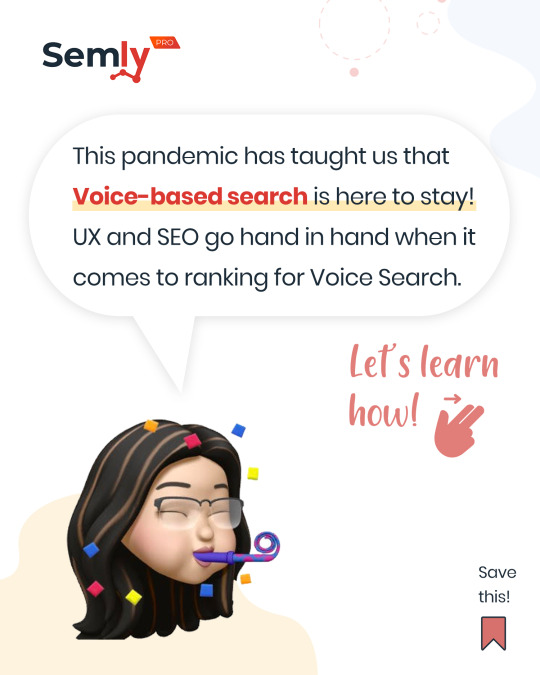
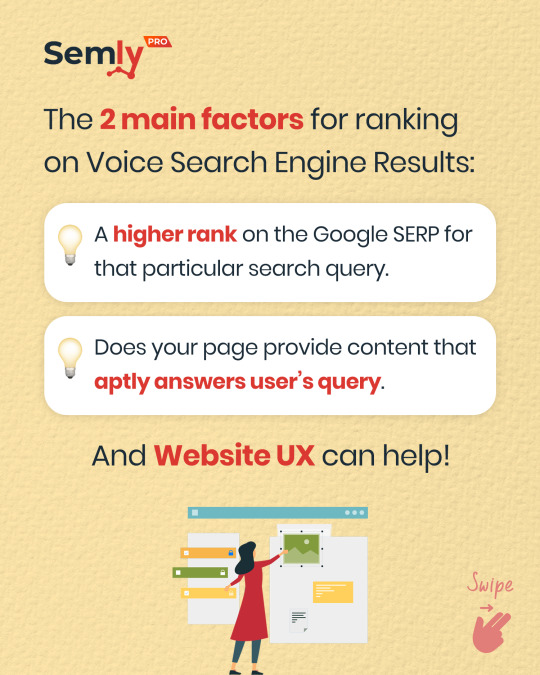
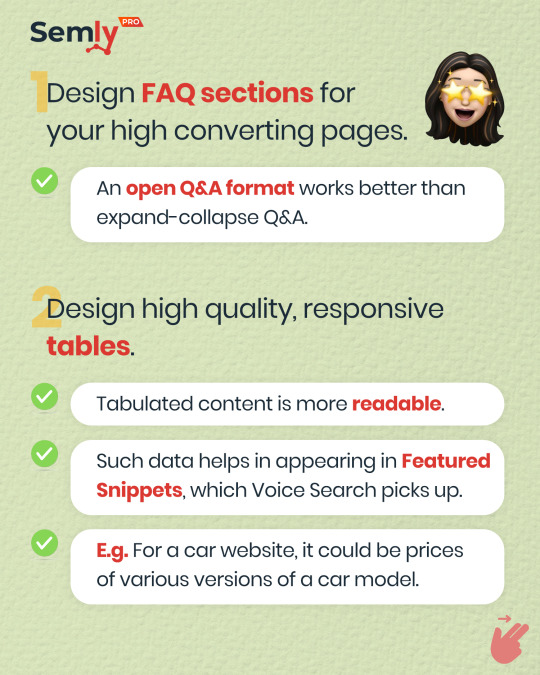
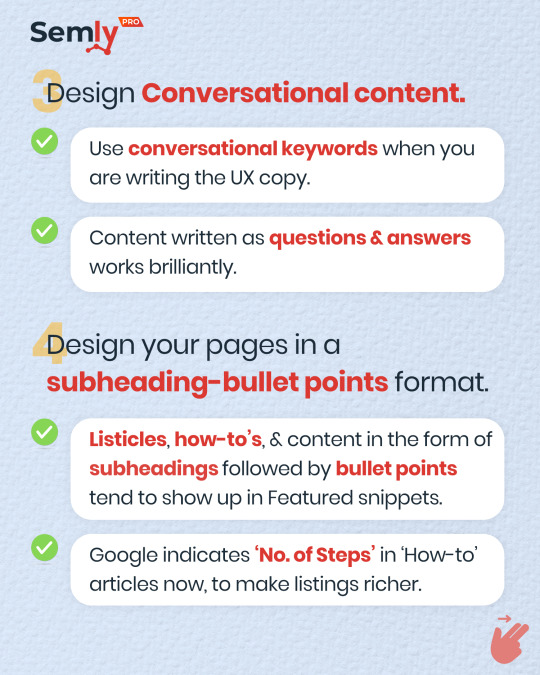
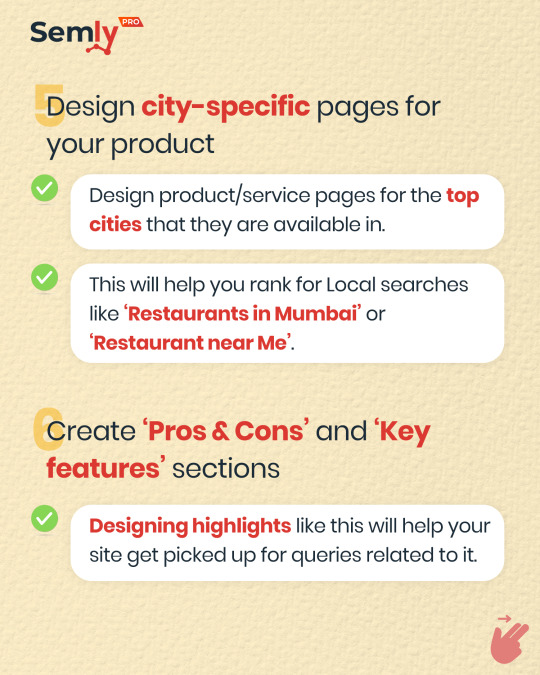
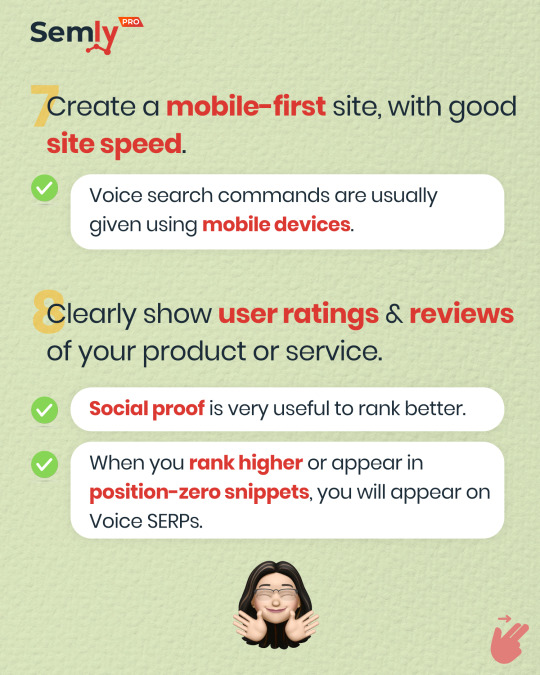
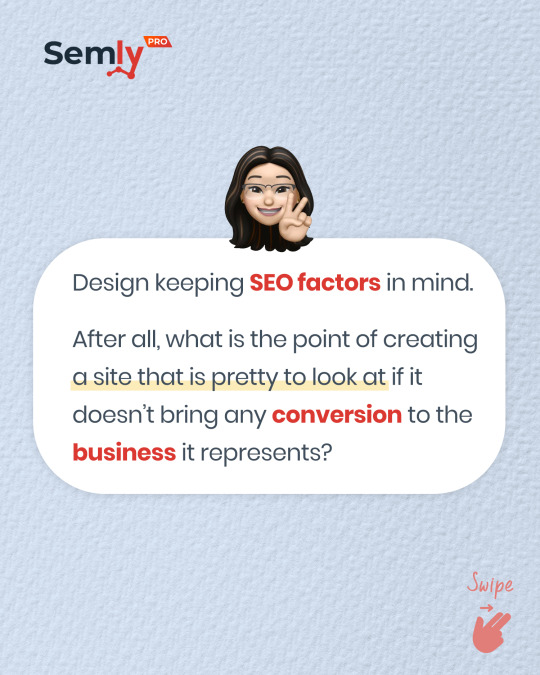
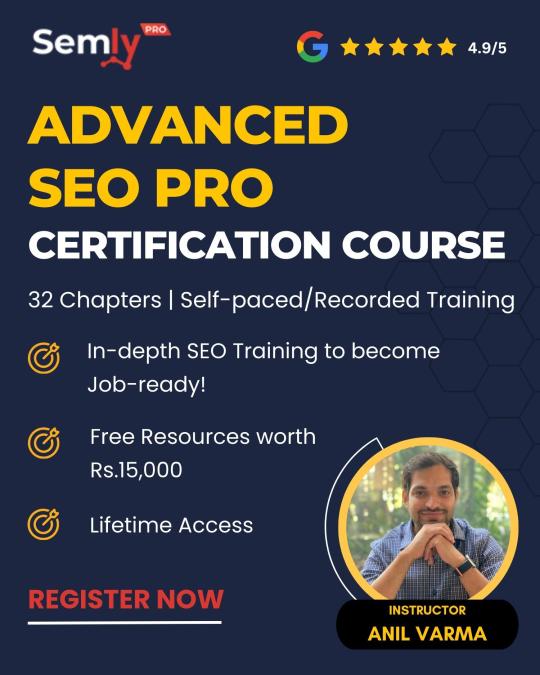
💡 Advanced SEO Pro Certification Course by Anil Varma - REGISTER NOW ❤️ Follow Semly Pro - The SEO Company for more SEO tips. 🎙 Content and Design by Surya Pillai.
#digital marketing#Digital Marketing Tips#search engine optimization#SEO#SEM#search engine marketing#ux#semly pro#semlypro#anil varma#user experience design#surya pillai#google#google search#google analytics
5 notes
·
View notes
Text
E-commerce SEO Strategies Unveiled: Boosting Sales and Visibility

In the ever-evolving landscape of e-commerce, staying ahead of the competition requires not only a compelling product but also a well-optimized online presence. In this comprehensive guide, we will delve into the world of E-commerce SEO optimization. No buzzwords, just actionable insights to enhance your online store's visibility and boost sales. Let's get started
Understanding the Basics
To lay a solid foundation, let's start with the basics. E-commerce SEO optimization involves a series of on-page and off-page strategies aimed at improving your website's ranking on search engine results pages (SERPs). This optimization is pivotal for attracting high-quality organic traffic, increasing sales, and staying competitive in the digital marketplace.
Keyword Research
The cornerstone of any successful SEO campaign is thorough keyword research. Begin by compiling a list of relevant keywords that reflect your products, services, and industry. In addition to your primary keywords, consider long-tail keywords, as they often have less competition and can yield highly targeted traffic. For instance, if you're a digital marketing agency in Seattle, keywords like "digital marketing services in Seattle" and "Seattle SEO company" are goldmines.
On-Page Optimization
High-Quality Content: Your website's content should not only be unique but also provide value to your audience. Craft product descriptions, blog posts, and landing pages that resonate with your target audience. Incorporate the primary and long-tail keywords naturally within the content while maintaining readability and a professional writing style.
Page Titles and Meta Descriptions: Ensure that each page has a unique and descriptive title tag and meta description. These elements should include relevant keywords and provide a concise summary of the page's content. This encourages users to click through to your website from the search results.
Header Tags: Use header tags (H1, H2, H3, etc.) to structure your content. This not only improves readability but also helps search engines understand the hierarchy of information on your pages.
User Experience (UX) Matters
Google values user experience, so make sure your website is user-friendly. Optimize for mobile devices, improve page load times, and ensure intuitive navigation. A seamless UX not only pleases visitors but also satisfies search engine algorithms.
Backlink Building
Off-page SEO is as crucial as on-page optimization. Seek high-quality backlinks from reputable websites in your industry. Guest posting, influencer collaborations, and participating in industry forums can all help in this regard.
Monitoring and Analytics
Track your SEO efforts using tools like Google Analytics and Google Search Console. Regularly review your website's performance, make necessary adjustments, and stay updated on SEO trends and algorithm changes.
Conclusion:
In the ever-competitive world of e-commerce, mastering SEO optimization is your key to success. By adhering to these strategies and tips, you can enhance your website's visibility, drive organic traffic, and ultimately boost your sales. If you're seeking expert assistance, consider partnering with AE Tech Design Agency, your trusted SEO company in Seattle. Contact us today to explore how our digital marketing services can elevate your online presence and drive meaningful results.
Remember, the world of SEO is constantly evolving, so staying informed and adapting your strategies accordingly is essential for long-term success.
#E-commerce SEO#SEO Optimization#E-commerce Strategies#SEO Tips#Organic Traffic#Search Engine Rankings#Keyword Research#On-Page SEO#Off-Page SEO#User Experience (UX)#Backlink Building#Local SEO#Google Analytics#Digital Marketing#SEO Trends#SEO Algorithm#Online Visibility#Website Performance#SEO Company#Seattle Digital Marketing
6 notes
·
View notes
Text
How to Use AI SEO to Improve Your Website by Neil Patel.
The internet has become the go-to source for everything from trivia about celebrities to fixing our kitchen sinks. But AI SEO may be changing the way marketers help their sites rank high on search engine results pages (SERPs). Failure to rank may result in your business missing out on valuable search traffic. Which means far less revenue for your business. For a long time, you could get by with basic SEO strategies. But not anymore. With artificial intelligence (AI) taking over the world, you need to up your game. What does that mean for your SEO strategy? To learn how AI and your SEO work together read the article at https://bit.ly/3suY3Td
#SEO#AI#artificial#intelligence#Business#SERPs#Search#Engine#Optimization#NeilPatel#Site#Traffic#UX#UI
3 notes
·
View notes
Text
Irrelevantly, and very much "old man yelling at clouds" thing.
But I'm sad that the desktop / web browser version of insta basically is like "Oh, you want to see more Remus fan art? Tired of just being only able to see like 9 of the most recently popular posts? Well too fucking bad, download the mobile app for your rat man fix!"
>:[
#insta aint my fave platform for lotsa reasons - i just know that's where a lot of the good shit is when tumblr's tag activity is a bit slow#and i know EVERYTHING abt of it was optimized for the mobile exp - browser / pc UX = COMPLETE afterthought
2 notes
·
View notes
Text
Tumblr~~ can you put it back to the house and / or at least make the page reload when I click on either the house or "following" like it was before? 😩 It's frustrating when it doesn't reload or only reacts after clicking 3 times.... it should refresh via the UI not me pressing F5 on my keyboard....

#tumblr#staff#yall know we don't like big changes here#UI / UX is called user interface experience for a reason cause it's about optimizing the users experience it should not make it worse :)#(and by experience it means what the use is already used to)
5 notes
·
View notes
Text
The Evolving Landscape of SEO: A Year of Transformations in Google's Algorithms and Beyond
Introduction: As a seasoned SEO professional, I have closely observed the dynamic nature of search engine optimization and the ever-changing algorithms employed by Google. Over the past year, the SEO industry has witnessed significant transformations that have reshaped the way websites design services are ranked, the appearance of search engine results pages (SERPs), the prominence of local SEO, and the integration of AI in SEO strategies. In this article, I will outline the top 10 changes in SEO and Google, highlighting the key insights and trends that have emerged during this transformative period.
Algorithm Updates:
Google's algorithm updates have always been a focal point for SEO professionals, and the past year has been no exception. From the introduction of Core Web Vitals as a ranking factor to the continuous refinement of algorithms like BERT and RankBrain, Google has been on a mission to provide users with more relevant and high-quality search results.
SERP Enhancements:
Google has been constantly refining the appearance of its SERPs to enhance user experience and provide more contextually relevant information. Features like featured snippets, knowledge panels, and local packs have become more prominent, leading to a shift in SEO strategies towards optimizing for these rich results.
Rise of Zero-Click Searches:
With the growing prevalence of featured snippets and rich results, there has been an increase in zero-click searches, where users find the information they need directly on the SERP without clicking through to a specific website. This trend has necessitated a shift in SEO focus towards optimizing content for visibility in featured snippets to maintain organic traffic.
Mobile-First Indexing:
Google's mobile-first indexing initiative reached a significant milestone over the past year, with mobile versions of websites websites design services becoming the primary basis for indexing and ranking. This shift has emphasized the importance of mobile optimization, responsive design, and fast-loading pages in SEO strategies.
Core Web Vitals:
Google's introduction of Core Web Vitals as a ranking factor has underscored the significance of user experience metrics like page speed, interactivity, and visual stability. SEO professionals are now paying closer attention to factors that directly impact the user's website experience, emphasizing the need for optimizing performance and enhancing overall website usability.
Local SEO Dominance:
The past year has seen a further rise in the importance of local SEO, driven by increased user reliance on local search for finding products and services. Google My Business (GMB) optimization, local citations, and the prominence of map packs have become critical elements in local SEO strategies, providing businesses with an opportunity to target specific geographical areas.
E-A-T and Content Quality:
Google's focus on expertise, authoritativeness, and trustworthiness (E-A-T) has continued to shape SEO practices, with an emphasis on producing high-quality, authoritative content. Websites that demonstrate expertise and provide trustworthy information are more likely to rank higher in search results, making E-A-T an essential consideration in content creation and optimization.
Voice Search and AI:
The integration of AI-powered voice assistants, like Google Assistant and Amazon Alexa, has had a profound impact on SEO. Optimizing for voice search and conversational queries has become crucial, as search engines strive to understand natural language patterns. SEO professionals are now adapting their strategies to align with the nuances of voice-based search and provide users with concise, contextually relevant answers.
User Intent Optimization:
Understanding and fulfilling user intent has become a fundamental aspect of SEO. Google's algorithms are becoming increasingly adept at deciphering user intent, and websites that align their content to match user expectations are rewarded with higher rankings. SEO professionals now focus on creating content that satisfies specific user queries and intents, driving more targeted organic traffic.
Machine Learning and RankBrain:
Google's RankBrain algorithm, which utilizes machine learning to process search queries and improve search results, has continued to evolve. SEO professionals are now harnessing the power of machine learning to gain insights, identify patterns, and refine their strategies. Advanced SEO tools and techniques powered by AI are becoming indispensable for effective keyword research, competitor analysis, and overall SEO performance.
Conclusion: The past year has been transformative for SEO, with Google's algorithm updates, changes in SERP appearance, the rise of local SEO, the integration of AI, and the evolving understanding of user intent. To stay ahead in this ever-evolving landscape, SEO professionals must continually adapt their strategies, optimize for mobile and user experience, prioritize local search, and leverage AI-powered tools. By embracing these changes and keeping a keen eye on emerging trends, SEO practitioners can thrive in the dynamic world of search engine optimization.
#SEO#Google Algorithms#Search Engine Optimization#SEO Trends#Digital Marketing#Google Updates#SEO Strategies#Algorithm Changes#SEO Best Practices#Website Optimization#SERP (Search Engine Results Page)#Organic Traffic#Content Marketing#SEO Techniques#Keyword Research#Link Building#Mobile SEO#Voice Search Optimization#User Experience (UX)#SEO Analytics
6 notes
·
View notes
Text
Custom web development enhances user experience by creating fast, responsive, and user-friendly websites tailored to your brand. It improves navigation, boosts engagement, and drives conversions, offering a competitive edge over generic templates.
#custom web development#user experience optimization#website development services#UX/UI design#web performance improvement#tailored website solutions#business website development#professional web design#responsive custom websites#user-centric web design
0 notes